Deborah Hufford's Blog: https://www.NotesfromtheFrontier.com, page 2
October 4, 2024
Today Commemorates One of the Most Tragic Milestones in American History
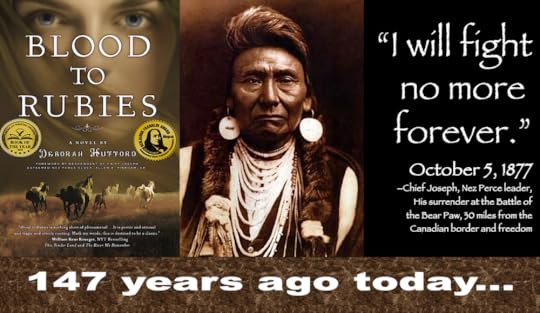 My bestselling novel, BLOOD TO RUBIES, 2023 BOOK OF THE YEAR, honors the story of Chief Joseph and the Nez Perce War of 1877. Two main characters are a Nez Perce woman warrior (based on a true character) who fought along Chief Joseph to save their people and an Irish immigrant woman homesteader who tried to help her. The story is told through a young frontier photographer, who is entangled between two clashing worlds, one being born and one being wiped from the earth.
My bestselling novel, BLOOD TO RUBIES, 2023 BOOK OF THE YEAR, honors the story of Chief Joseph and the Nez Perce War of 1877. Two main characters are a Nez Perce woman warrior (based on a true character) who fought along Chief Joseph to save their people and an Irish immigrant woman homesteader who tried to help her. The story is told through a young frontier photographer, who is entangled between two clashing worlds, one being born and one being wiped from the earth. In 1877, Chief Joseph and his Nez Perce tribe faced the end of their tribe's civilization as a free people. Joseph--his Nez Perce name was "Thunder Rolling from the Mountains"--was the last chief to stand against white invasion in a major war with the U.S. The ultimate irony was that his tribe had saved Lewis and Clark from starvation and freezing to death 74 years before, then showed them the Northwest Passage to the Pacific. For decades, Chief Joseph had resisted treaties to give up the land and move to a reservation. But on May 15, 1877, U.S. General Howard told Joseph they must give up their land or fight. They could no longer roam the millions of magnificent acres of the Pacific Northwest near Yellowstone, their land for 15,000 years.
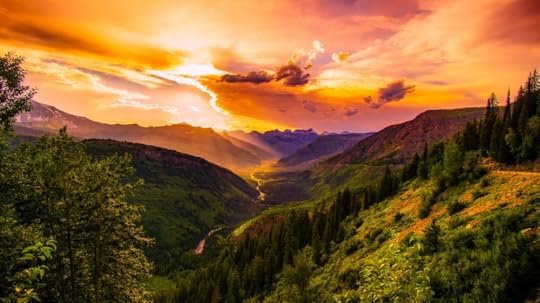
Joseph knew the only way the Nez Perce would be free was to escape to the "Medicine Line," the Canadian border. He and several other chiefs gathered their people and their thousands of horses, including their prized Appaloosas.
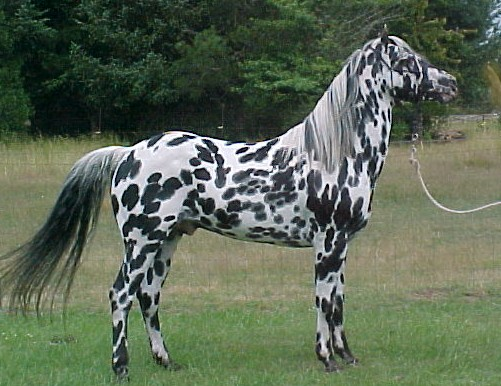
For the next five months and 1,500 miles, the Nez Perce fought off several pursuing U.S. armies commanded by the several of the best Civil War Generals, including Sherman. Through the roughest terrain on the face of the earth, including the Rockies, the Bitterroots, the Continental Divide twice, and Hell's Canyon, the deepest gorge in the North American continent,
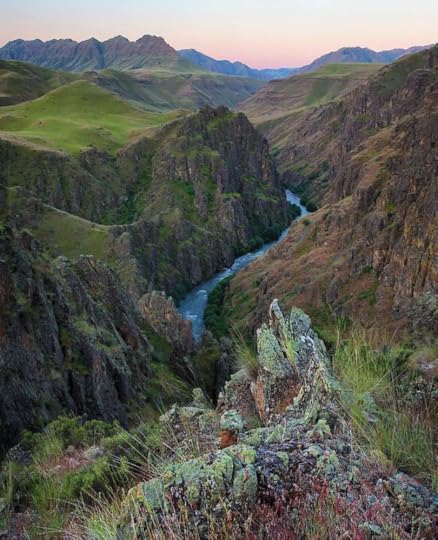
The nation watched in awe as they won against much greater numbers with heavy artillery, fresh horses and multiple armies. Newspapers called Joseph "The Red Napoleon." (Their tactics were so brilliant they came to be taught at West Point.) The nation found itself rooting for the underdog.
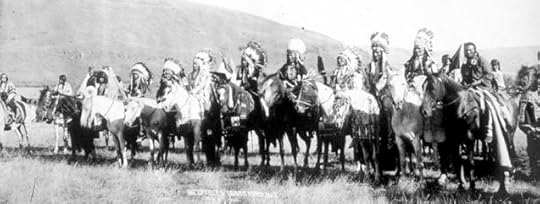 BLOOD TO RUBIES features 70 black and white archival photographs, including this picture captured in 1877 depicting Nez Perce warriors and Chief Joseph during the Nez Perce War.
BLOOD TO RUBIES features 70 black and white archival photographs, including this picture captured in 1877 depicting Nez Perce warriors and Chief Joseph during the Nez Perce War. One historic fact that has been written out of history nearly entirely is the existence of women warriors. They existed on all continents and they existed among many Native American tribes, including the Nez Perce. This was especially true in the Nez Perce War of 1877. One of the main characters in BLOOD TO RUBIES is a Nez Perce woman warrior based on a true historical character who fought along Chief Joseph.
 Women warriors have consistently been written out of history, including Native warrior women. A main character in BLOOD TO RUBIES is a Nez Perce warrior woman based on a true character.
Women warriors have consistently been written out of history, including Native warrior women. A main character in BLOOD TO RUBIES is a Nez Perce warrior woman based on a true character.
The Nez Perce almost made it. Only 30 miles from the Canadian border, many wounded and elderly were dying and the children freezing to death,
Chief Joseph and a handful or warriors, including women, opted to stay behind with the elderly, wounded and sick children who could not ride the last 30 miles to Canada. Chief Joseph was giving his people time to escape to Canada while he held off the cavalry converging from three directions and commanded by three leading Civil War generals. Joseph surrendered at the Battle of the Bear Paw on October 5, 1877 and uttered the famous words: "From where the sun now stands, I will fight no more forever."
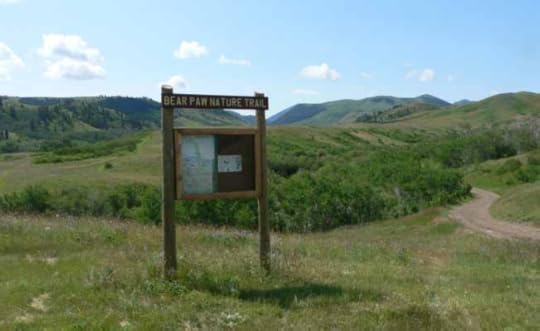
You may also enjoy these related posts:
• Chief Joseph's Terrible Dilemmahttps://www.notesfromthefrontier.com/post/chief-joseph-s-terrible-dilemma
• A Modern-Day Tribute to Chief Josephhttps://www.notesfromthefrontier.com/post/a-modern-day-tribute-to-chief-joseph
• In the Steps of Chief Josephhttps://www.notesfromthefrontier.com/post/in-the-steps-of-chief-joseph-1
• The Chief Joseph Foundation: Honor Joseph's Legacyhttps://www.notesfromthefrontier.com/post/honor-chief-joseph-s-legacy-nov-9-22
• The Saga of Jackson Sundownhttps://www.notesfromthefrontier.com/post/the-saga-of-jackson-sundown
©2024 Notes from the Frontier
August 31, 2024
Rodeo Queen Turned Bestselling Novelist
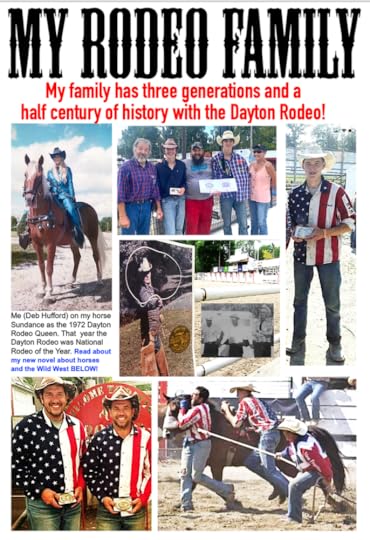
For most Americans, the Labor Day weekend is a time for picnics, barbecues, and get-togethers before summer ends and school begins. But, for me, it means something completely different: four days of the annual Dayton, Iowa, Rodeo! I grew up in rural north central Iowa. My home town of Dayton, Iowa, at the time population 500, was home to one of the nation's leading rodeos. And also one of the nation's oldest.
 My childhood horse, Sundance, was my pride and joy. He was a celebrity among all the children in town. When he died, at the ripe old age of 30, our smaltown newspaper ran his obituary.
My childhood horse, Sundance, was my pride and joy. He was a celebrity among all the children in town. When he died, at the ripe old age of 30, our smaltown newspaper ran his obituary.
I grew up with horses and as an Iowa farm girl, working on farms to board my horse Sundance, mucking out stalls, feeding cattle, farrowing pigs, walking beans. detasseling corn, baling hay, and driving tractors. I was a hardcore cowgirl who always rode my horse, Sundance, bareback and also trained green horses (I don't like to call it "broke"). I was a member of the Dayton Wrangler's Club and Dayton Rodeo Queen in 1972 (yep! that's right––52 years ago!) when our rodeo was National Rodeo of the Year.
 My middle sister, Sue (far right), followed my rodeo footsteps by participating in the first All-Women Ride Horse Race in the Dayton Rodeo. Rough stuff and very dangerous! Sue's sons and grandsons (son Marshall, middle, grandson Maverick, 2nd from left and Xander, 2nd from right all became veteran wild horse race champions, as did their dad, Robin, far left. FYI, my sister Sue is one tough woman! She was also the arm-wrestling champion in Iowa!❤️
My middle sister, Sue (far right), followed my rodeo footsteps by participating in the first All-Women Ride Horse Race in the Dayton Rodeo. Rough stuff and very dangerous! Sue's sons and grandsons (son Marshall, middle, grandson Maverick, 2nd from left and Xander, 2nd from right all became veteran wild horse race champions, as did their dad, Robin, far left. FYI, my sister Sue is one tough woman! She was also the arm-wrestling champion in Iowa!❤️
 My two nephews (far left), Sue's sons Marshall (left) and Michael, won seven championships at the Dayton rodeo. Now Marshall's sons, Xander and Maverick, are following in their dad's footsteps, or rather.... cowboy boots! My grand-nephew, Xander (above far right), graduated last year from high school and is already a rodeo veteran and is now a professional bronc rider. Xander holds the Dayton Rodeo record for the youngest person to win the Wild Horse Race at the Dayton Rodeo.
My two nephews (far left), Sue's sons Marshall (left) and Michael, won seven championships at the Dayton rodeo. Now Marshall's sons, Xander and Maverick, are following in their dad's footsteps, or rather.... cowboy boots! My grand-nephew, Xander (above far right), graduated last year from high school and is already a rodeo veteran and is now a professional bronc rider. Xander holds the Dayton Rodeo record for the youngest person to win the Wild Horse Race at the Dayton Rodeo.
The Dayton [Iowa] Rodeo is one of the oldest rodeos in the U.S. and was established in 1937 by three Dayton residents (shown below in inset). One of them, Allen Porter (shown below. left), was a real-life cowboy of legendary lore. He worked on ranches out west for much of his youth. He was very tall and handsome, sort of the cowboy version of Rhett Butler. And he was a trick roper and veteran rodeo rider.
Later in his life, Allen became the town ferrier. He shoed my horse Sundance many times. He put carrots in his back pockets and Sundance would eat them while he worked on his hooves. Allen lived to be 98 and most likely would have made it to 100, had a house fire not taken his life. He was not only a true cowboy, but a true gentleman.

I have an another interesting and heartbreaking anecdote to relate about Allen and his cowboy life: All through high school, aside from working on farms to board my horse, I also worked at the local care home on the weekends to save for college. One patient there I cared for was named Velda Porter. She was an old woman then, but still had jet black hair. By her bedside, she had an old black and white photograph of herself and Allen on horses. They were a young married couple, Hollywood gorgeous, like Scarlett O'Hara and Rhett Butler. Velda was a very accomplished horsewoman, too. The story was that she has half Sioux Indian.
Probably not long after that photograph was taken in her early 20s, she was thrown by a horse and suffered very serious brain damage that left her physically incapacitated and childlike. She had been in a care home for 35 years. I was deeply affected by that experience, as she had been the first Dayton rodeo queen in 1937. I cared for her while I was Rodeo Queen decades later. It was one of those experiences from my childhood that stuck with me and inspired me to write my novel much later.
 Postscript:
Postscript:My debut novel, BLOOD TO RUBIES was published less than a year ago.
You can read reviews, a synopsis, and order the book at this Amazon link:
"Rodeo Queen Turned Bestselling Novelist" was first published on Facebook and NotesfromtheFrontier.com on September 2, 2024.
©2024 NOTES FROM THE FRONTIER
August 17, 2024
Beneath All of Us Is Native History
If you live in North America––or any of the Americas––you live on Native land full of Native history.
Native history is all around us and beneath us if we care to notice. I've been lucky to live in an area rich in Native culture, while writing my debut novel, BLOOD TO RUBIES, about Chief Joseph and the cataclysmic clash of white and Native cultures. It's been a tremendous inspiration for me to be surrounded by Native American footprints, relics of pioneer life and the wonderful natural world.
I live on the shores of Lake Michigan out in the country in Wisconsin. I also live on what was once a main thoroughfare of tribes traveling and trading up and down the Great Lakes along Lake Michigan, as far north as what it today Michigan and Canada and as far south as Chicago and St Louis and beyond. In fact, major roads in many cities were once main trails of the Native tribes who lived there originally. The ancient paths of Native tribes live on in our modern highway systems.
 This life-size bronze statue (above) of the French explorers Marquette and Jolliet is perched majesticallyt on a high cliff overlooking the shoreline of Lake Michigan less than a half mile from my home! In 1673––350 years ago––the two explorers canoed up the shores of Lake Michican exploring the land. I love to imagine that the Native people who lived on the land I now live on watched them from the shoreline!
This life-size bronze statue (above) of the French explorers Marquette and Jolliet is perched majesticallyt on a high cliff overlooking the shoreline of Lake Michigan less than a half mile from my home! In 1673––350 years ago––the two explorers canoed up the shores of Lake Michican exploring the land. I love to imagine that the Native people who lived on the land I now live on watched them from the shoreline!
I'm also lucky that I live in an area that is full of Native and pioneer history. Within a quarter of a mile of my home are three pioneer log cabins that date back to 1840 and the remnants of stone fences that were built when those homesteaders cleared their land for farming. The land is also lined with stone fences and remnants of stone fences, now buried by undergrowth, leaves and soil.
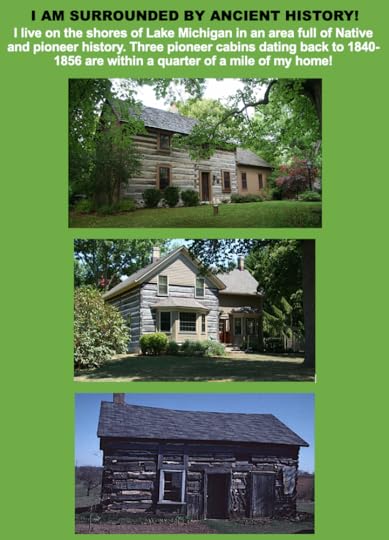
I have found several fascinating Indian artifacts in our backwoods: arrowheads, a grinding stone embedded in the earth and what we believe to be stone scrapers. (See picture below,) The grinding stone, which looks to be granite, has a deep channel worn down the middle with obivious scraping marks in the stone. I wonder how long it took to wear down that granite with stone scrapers? I would think generations. Can any archeologists or Native artifact experts comment on this picture? Do the two rocks below the grinding stone look like Indigenous scrapers?
 This is a Native grinding stone that is still embedded in our back woods in Wisconsin. In the middle of the stone, slightly smaller than the size of basketball, is a trough that was worn down by grinding perhaps corn, nuts, berries and other foodstuffs with stone scrapers. We found what appear to be stone scrapers on our land, but not near the grinding stone. When I discovered this amazing artifact from perhaps centuries or thousands of years ago, I had chills down my spine.
This is a Native grinding stone that is still embedded in our back woods in Wisconsin. In the middle of the stone, slightly smaller than the size of basketball, is a trough that was worn down by grinding perhaps corn, nuts, berries and other foodstuffs with stone scrapers. We found what appear to be stone scrapers on our land, but not near the grinding stone. When I discovered this amazing artifact from perhaps centuries or thousands of years ago, I had chills down my spine.
Our two acres of land includes a woods that we believe was once part of much larger oak savannah. Only a few of the giants oaks remain, two of them on our land.
The standing oak shown below, top, has a trunk about three feet wide. Another nearby old-growth oak fell on our property, I felt the ground shake in our home, when it fell. It was about the same size as our still-standing oak . The grinding stone embedded in the ground is about six feet from the standing oak tree, below.
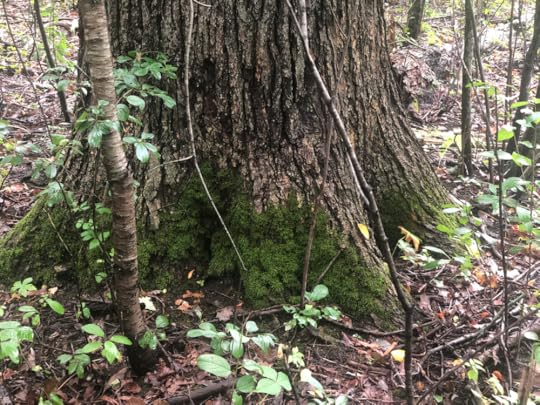
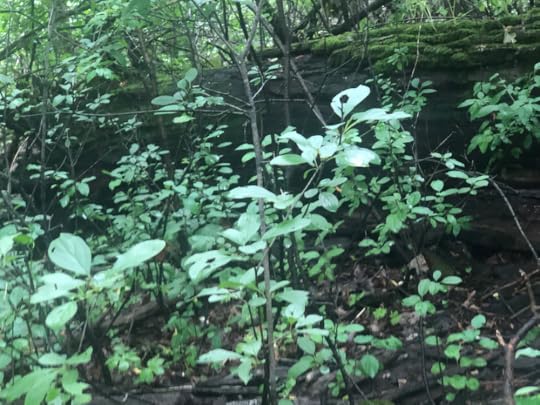
I like to believe that there was a Native village or a family who lived on this land. I've found no evidence of Indian burial mounds in the area, although Wisconsin has many. Pioneer farmers and developers in more recent times often plowed over or dug up Indian mounds to clear the land and robbed bones and funerary artifacts as souvenirs. That is a brutal and tragic fact. I often wonder where their graves were?
Do you have any stories about the land you live on? Please share them here! These discoveries always remind me that we are only passing through, only stewards of the land.
You can read a synopsis and great reviews of my bestselling and award-winning debut novel, BLOOD TO RUBIES, at this Amazon link:
"Beneath Us Is Native History" was first posted on Notes from the Frontier and Facebook on August 17, 2024.
You may be interested in these related posts from Notes from the Frontier :
• "My Childhood Haunts: Indian Mounds"
https://www.notesfromthefrontier.com/post/my-childhood-haunts-iowa-indian-mounds
• "States with Indian Names"
• "America's Earliest Cities Were Native"
https://www.notesfromthefrontier.com/post/america-s-earliest-cities-were-native-american-spanish
• "Today's Largest Indian Tribes"
https://www.notesfromthefrontier.com/post/today-s-largest-indian-tribes
©2024 NOTES FROM THE FRONTIER
May 27, 2024
THE GREAT BLOOD TO RUBIES IOWA BOOK TOUR WAS A GREAT SUCCESS!
Filled with gratitude to have been the Featured Speaker at my high school alumni banquet. Nearly 170 people What a wonderful homecoming! Thank you Dayton, Iowa! Thank you Williamsburg, Iowa! Thank you Lehigh, Iowa! Thank you Dayton Alumni Banquet Planning Committee! My heart is full
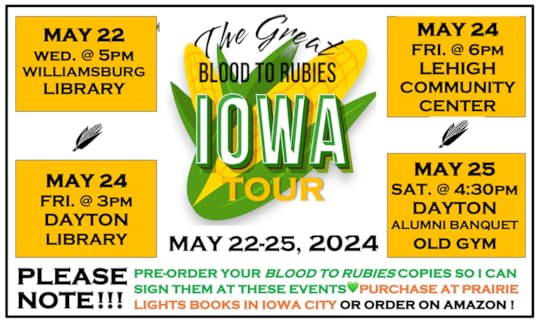
Here are some fun highlights!
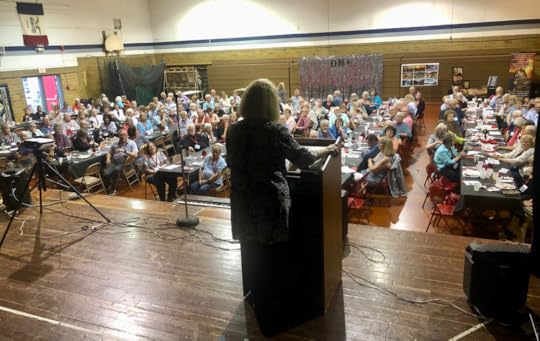
Here I am speaking about my debut novel, BLOOD TO RUBIES, at my high school all-class reunion at the Dayton, Iowa, Alumni Banquet––170 attendees! Pretty darn good for a small farming community of 700❣️ Many of the characters and place names in my debut novel were inspired from my childhood growing up in Dayton.
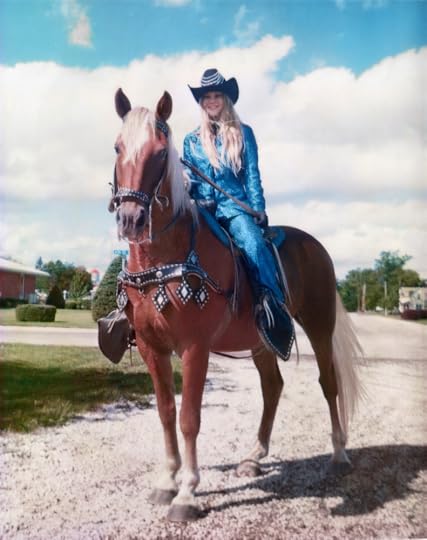
Dayton has a very famous national rodeo. I was a rodeo queen a half century ago! Here is my amazing horse, Sundance. When he died, the town newspaper, The Dayton Review, ran his obituary
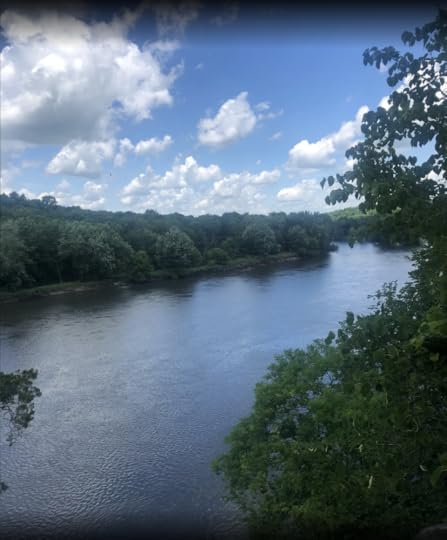
I rode Sundance--almost always bareback--throughout Webster County on remote country roads, dirt and gravel. My favorite place was riding along the Des Moines River Valley. There, Sundance and I explored an old abandoned coal mine and ghost town called Hardscrabble, Indian mounds, buffalo wallows, an abandoned stage coach trace, pioneer ruins, and we enjoyed spectacular wildlife. You'll find all of this in my debut novel, BLOOD TO RUBIES. PHOTO BY MADELINE DARLAND.
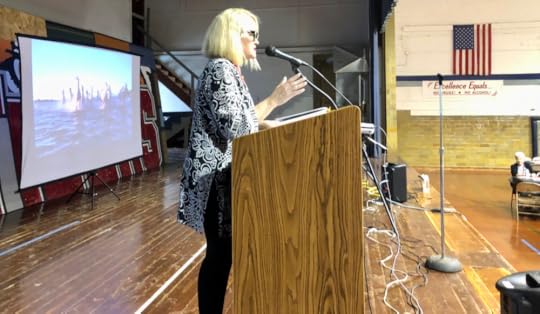
DAYTON INSPIRATIONS
During my presentation, I recounted many of the inspirations in BLOOD TO RUBIES from Dayton and my childhood. Here are just a few: Allen Porter (who founded the Dayton rodeo); a herd of Appaloosas led by a leopard stallion that grazed in the Des Moines River Valley where I rode as a child); the Maple Leaf Cafe (where I worked as a waitress in high school; Danny Stoneburner (my classmate, who was also a grill cook there); the Rusty Spur (our town tavern); Helga (an old Scandinavian widow and hoarder who lived in the heart of Dayton on a half block buried in trees and collapsed buildings); Fred Jebron (an old farmer who drove a beaten down John Deere tractor. His three-legged rat terrier always ran under the back axle); Marilyn Sandholm's big oak tree (Marilyn was the town piano teacher who taught me and most of the kids in Dayton. At the corner of her property was a big oak tree that used to scare the wits out of me at night); the "three sisters" trees ( three huge elm trees in the front of McElvain's sheep farm next to my parents' home. I used to play under those trees and called them "the three sisters," just like little Ella in BLOOD TO RUBIES. Later, I pastured Sundance in Mr. and Mrs. McElvain's sheep pastures; Erma Kay and Burton Yale (two oldsters from Dayton. Later, when I became friends with Erma Kay, I discovered that she and her husband had been vaudevillians early in the 1900s! They make an appearance in my book); old pioneer ruins near Skillet Creek in back of Dan Bohlke's childhood home (you'll find this inspiration in the chapter, sumac dreams); Velda Porter (the first Dayton Rodeo Queen and Allen Porter's first wife, who had suffered severe brain damage as a young woman after being kicked in the head by a horse. When I was the Dayton Rodeo Queen, I cared for her in the Dayton Care Home, where I worked all through high school. That was a profound experience, as were so many of my childhood experiences growing up in Dayton.) Read BLOOD TO RUBIES to discover even more inspirations from Dayton!
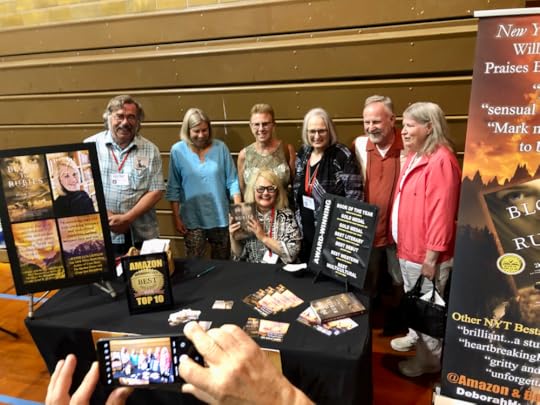
Above are my classmates from the Class of 1972 who attended the Banquet posing with me and BLOOD TO RUBIES. There were originally only 26 of us graduates! Thank you so much, dear friends (Bruce, Sandi, Sharon, Judy, Mark and Gail) for attending and sharing this amazing life experience with me Two other classmates, Dan Bohlke and his wife Roxie and Rick Dayton and his wife Paula attended our Williamsburg Library event several days before, as they all live in Iowa City. So very thrilled to see all of you! Love you all❣️

Above, from left to right: My amazing 92-year-old mother and heroine, Dorothy Hufford, and my husband, kidney donor and hero, Evan Jones; my wonderful two sisters, Scheila (left) and Sue (right); and my role model and mentor growing up, spectacular horsewoman, former Dayton Rodeo Queen (like me), and all-around wonderful woman, Kay Owen. Love you all❣️
I especially want to thank the Dayton Alumni Banquet Committee, especially Barb Sandholm, Brent Sandholm and Gary Sandholm and Jack and Davonne Burns. (I hope I didn't miss other names. If I did, my sincere apologiesPlease comment below, if I did.) As I mentioned in my presentation, these folks have worked very hard for years to plan these events, which are so vital to keeping Dayton's 170-year history alive, as well as our childhood friendships. That is sacred work! Thank you all so much Also a big thank you to Judy and Joann Nemechek, who began the tradition of these banquets and also worked for many years to continue this important tradition. Many thanks to the wonderful Neil Blair for serving as the Banquet's MC this year. What a wonderful and generous man!
Thank you also to the many librarians I worked with to make our library events possible:
• Brianna White and Sandy Jones, of the Williamsburg Library
• Courney Sogard, Dayton Library Director
• Erin Murray, Lehigh Library Director and her dad, Harold Murray

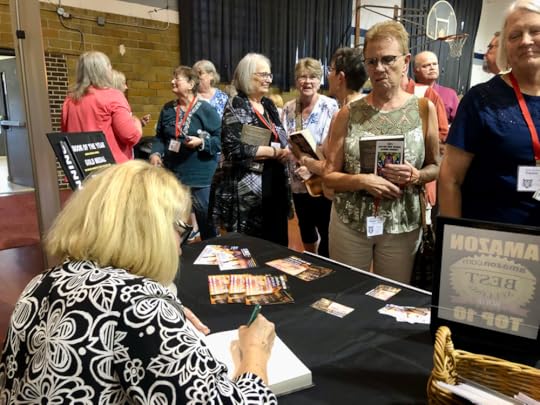
And, last but certainly not least, my sincere thanks to the 170 Dayton alumni who attended this event and the many of you who have read my book and brought them to be autographed. It means so very much to me that my old childhood friends and Dayton alumni have supported me and have been so loyal.
Bless you all and keep you
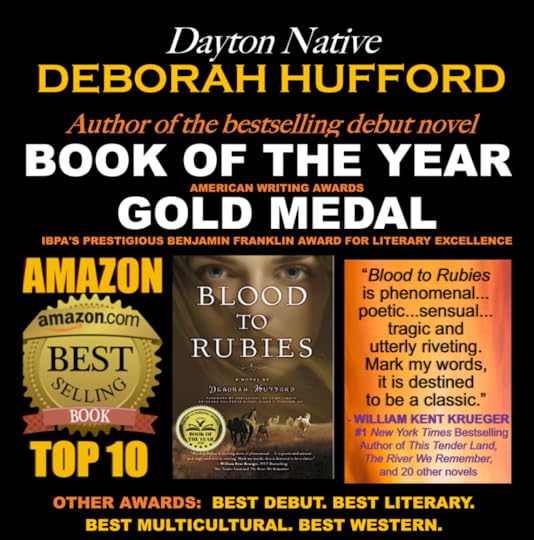
A Special Note
For all of you who have purchased and read BLOOD TO RUBIES, thank you!! Please know that every time you purchase BLOOD TO RUBIES (in any format) a portion of each sale goes to the Chief Joseph Foundation (ChiefJosephFoundation.org), in honor of Chief Joseph and the Nez Perce tribe, and the Chieftain and former Chair of the Tribe, Allen V. Pinkham, Sr., a descendant of Chief Joseph, who helped me vet my book and wrote a lovely Foreword.

"THE GREAT BLOOD TO RUBIES IOWA BOOK TOUR" was first published on Facebook and NotesfromtheFrontier.com on Memorial Day, May 27, 2024.
©2024 NOTES FROM THE FRONTIER
May 4, 2024
CELEBRATING THE 150TH KENTUCKY DERBY TODAY
I've always been a horse lover and grew up with horses. Watching the Kentucky Derby was an annual [virtual] pilgrimage for me since I was 8-years-old. I've only missed two of them and I'm 70 now. (Much of the luster of horse racing has been tarnished today by epidemic deaths of race horses, especially at Churchill Downs. So I honor this day with a deeply bittersweet heart and mourn the gallant horses lost. I believe that far more oversight and legislation is needed to protect race horses.)

When I was one-year-old, my parents and my grandmother visited Calumet Farms in Kentucky, and I got to pet the Triple Crown winner, War Admiral, son of the iconic Man o 'War. I fed him grass too. My mother took a picture of my dad holding me while I reached out to War Admiral. Sadly, that black-and-white photograph taken with my Mother's Brownie camera has been lost. It was one of my most precious possessions. But I do still have a picture of my mother, Dorothy Hufford, at Calument Farm petting War Admiral and his pasture mates in 1955 (above).
In honor of the 150th Kentucky Derby, I am featuring a reprint of one of my favorite journalists, Heather Cox Richardson. She posted this yesterday
May 3, 2024 post by Heather Cox Richardson:
TEN FAMOUS AMERICAN HORSES
It has been quite a week of news, and I’m willing to bet I’m not the only one who’s tired. So I figure it wouldn’t be the worst thing in the world to look elsewhere for a bit of a break. Tomorrow is the 150th running of the Kentucky Derby, and in its honor, I'm posting a piece my friend Michael S. Green and I wrote together a number of years ago on Ten Famous American Horses. It has no deep meaning...it’s just fun. And it was totally fun to research, too: I watched hours and hours of Mr. Ed and read television history to try to figure out what made it such a popular show. This remains one of my favorite things I ever had a hand in writing.
TEN FAMOUS AMERICAN HORSES

1) TRAVELLER
General Robert E. Lee rode Traveller (spelled with two Ls, in the British style) from February 1862 until the general’s death in 1870. Traveller was a grey American Saddlebred of 16 hands. He had great endurance for long marches, and was generally unflappable in battle, although he once broke both of General Lee’s hands when he shied at enemy movements. Lee brought Traveller with him when he assumed the presidency of Washington and Lee University. Traveller died of tetanus in 1871. He is buried on campus, where the safe ride program still uses his name.
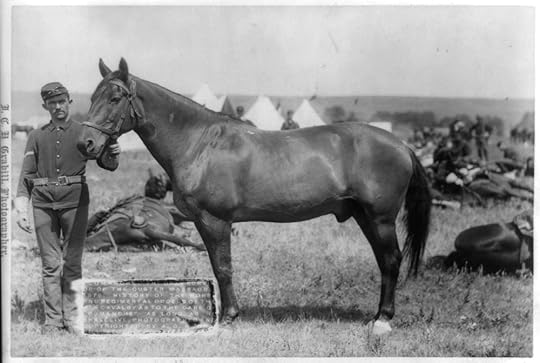
2) COMANCHE
Comanche was attached to General Custer’s detachment of the 7th Cavalry when it engaged the Lakota in 1876 at the Battle of Little Bighorn. The troops in the detachment were all killed in the engagement, but soldiers found Comanche, badly wounded, two days later. They nursed him back to health, and he became the 7th Cavalry’s mascot. The commanding officer decreed that the horse would never again be ridden and that he would always be paraded, draped in black, in all military ceremonies involving the 7th Cavalry. When Comanche died of colic in 1891, he was given a full military funeral (the only other horse so honored was Black Jack, who served in more than a thousand military funerals in the 1950s and 1960s). Comanche’s taxidermied body is preserved in the Natural History Museum at the University Of Kansas.
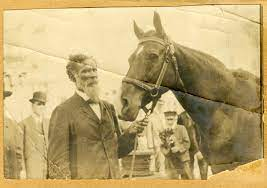
3) BEAUTIFUL JIM KEY
Beautiful Jim Key was a performing horse trained by formerly enslaved veterinarian Dr. William Key. Key demonstrated how Beautiful Jim could read, write, do math, tell time, spell, sort mail, and recite the Bible. Beautiful Jim performed from 1897 to 1906 and became a legend. An estimated ten million Americans saw him perform, and others collected his memorabilia—buttons, photos, and postcards—or danced the Beautiful Jim Key two-step. Dr. Key insisted that he had taught Beautiful Jim using only kindness, and Beautiful Jim Key’s popularity was important in preventing cruelty to animals in America, with more than 2 million children signing the Jim Key Band of Mercy, in which they pledged: “I promise always to be kind to animals.”
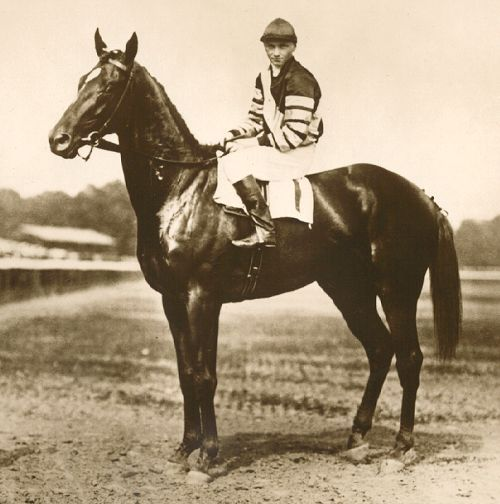
4) MAN O' WAR
Named for his owner, August Belmont, Jr., who was overseas in World War I, Man o’ War is widely regarded as the top Thoroughbred racehorse of all time. He won 20 of his 21 races and almost a quarter of a million dollars in the early twentieth century. His one loss—to “Upset”—came after a bad start. Man o’ War sired many of America’s famous racehorses, including Hard Tack, which in turn sired Seabiscuit, the small horse that came to symbolize hope during the Great Depression.

5) TRIGGER
Entertainer Roy Rogers chose the palomino Trigger from five rented horses to be his mount in a Western film in the 1930s, changing his name from Golden Cloud to Trigger because of his quick mind and feet. Rogers rode Trigger in his 1950s television series, making the horse a household name. When Trigger died, Rogers had his skin draped over a Styrofoam mold and displayed it in the Roy Rogers and Dale Evans Museum in California. He also had a 24-foot statue of Trigger made from steel and fiberglass. One other copy of that mold was also made: it is “Bucky the Bronco,” which rears above the Denver Broncos stadium south scoreboard.
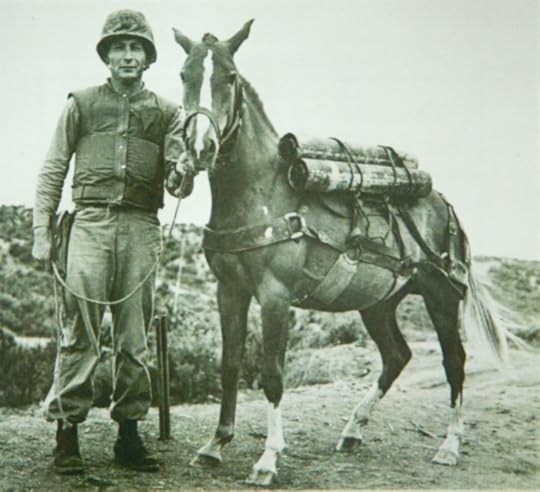
6) SERGEANT RECKLESS
American Marines in Korea bought a mare in October 1952 from a Korean stable boy who needed the money to buy an artificial leg for his sister, who had stepped on a land mine. The marines named her Reckless after their unit’s nickname, the Reckless Rifles. They made a pet of her and trained her to carry supplies and to evacuate wounded. She learned to travel supply routes without a guide: on one notable day she made 51 solo trips. Wounded twice, she was given a battlefield rank of corporal in 1953 and promoted to sergeant after the war, when she was also awarded two Purple Hearts and a Marine Corps Good Conduct Medal.
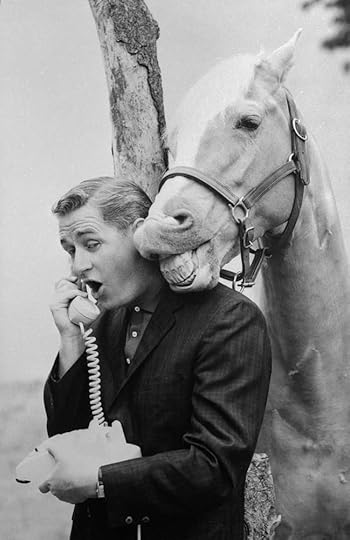
7) MR. ED
Mr. Ed was a talking palomino in a 1960s television show by the same name. At a time when Westerns dominated American television, Mr. Ed was the anti-Western, with the main human character a klutzy architect and the hero a horse that was fond of his meals and his comfortable life, and spoke with the voice of Allan “Rocky” Lane, who made dozens of “B” westerns. But the show was a five-year hit as it married the past to the future. Mr. Ed offered a gentle, homely wisdom that enabled him to straighten out the troubles of the humans around him. The startling special effects that made it appear that the horse was talking melded modern technology with the comforting traditional community depicted in the show.
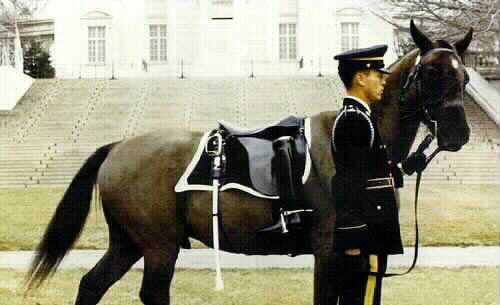
8) BLACK JACK
Black Jack, named for John J. “Black Jack” Pershing, was the riderless black horse in the funerals of John F. Kennedy, Herbert Hoover, Lyndon Johnson, and Douglas MacArthur, as well as more than a thousand other funerals with full military honors. A riderless horse, with boots reversed in the stirrups, symbolized a fallen leader, while Black Jack’s brands—a U.S. brand and an army serial number—recalled the army’s history. Black Jack himself was buried with full military honors; the only other horse honored with a military funeral was Comanche.
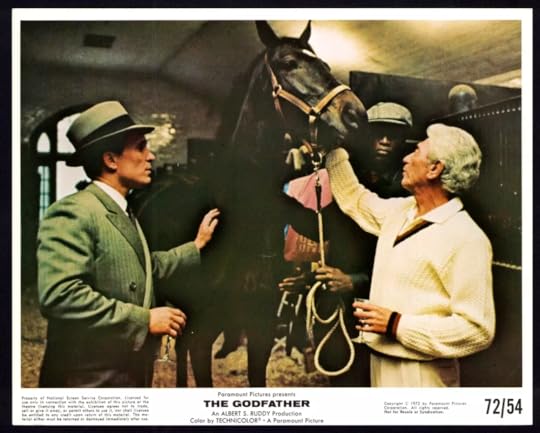
9) KHARTOUM
Khartoum was the prize stud horse of Jack Woltz, the fictional Hollywood mogul in Mario Puzo’s The Godfather. In one of the film version’s most famous scenes, after Woltz refuses requests from Don Vito Corleone to cast singer Johnny Fontane in a movie, Woltz wakes up to find Khartoum’s head in bed with him… and agrees to use Fontane in the film. In the novel, Fontane wins the Academy Award for his performance. According to old Hollywood rumor, the story referred to real events. The rumor was that mobsters persuaded Columbia Pictures executive Harry Cohn to cast Frank Sinatra in From Here to Eternity. As Maggio, Sinatra revived his sagging film career and won the Oscar for Best Supporting Actor.

10) SECRETARIAT
Secretariat was an American Thoroughbred that in 1973 became the first U.S. Triple Crown winner in 25 years. His records in the Kentucky Derby, the Preakness Stakes, and the Belmont Stakes still stand. After Secretariat was stricken with a painful infection and euthanized in 1989, an autopsy revealed that he had an unusually big heart. Sportswriter Red Smith once asked his trainer how Secretariat had run one morning; Charlie Hatton replied, “The trees swayed.”
You may also be interested in these related posts:
• "For the Love of Horses (and Mules)
https://www.notesfromthefrontier.com/post/for-the-love-of-horses-mules
• "Horses of Hollywood Westerns"
https://www.notesfromthefrontier.com/post/horses-of-hollywood-westerns
NOTE: Go to the HORSES category in the menu above to see many more posts about horses.
"CELEBRATING THE 150TH KENTUCKY DERBY TODAY" was first printed on Notes from the Frontier and Facebook on Saturday, May 4, 2024.
© 2024 NOTES FROM THE FRONTIER
April 23, 2024
A Brief Early History of My Tiny Hometown: Dayton, Iowa

The Louisiana Purchase of 1803 from France covered 500 million acres of land West of the Mississippi River. That purchase and Lewis and Clark's exploration of western regions in 1805-06 opened the floodgates of white western expansion across the continent. Iowa would be the 29th state to join the Union in 1846. But it wasn't the first state west of the Mississippi. Louisiana would be ratified far sooner, in 1812, because of the French's early settlement; Missouri in 1821; Arkansas in 1836, and Texas in 1845. All would be ratified before Iowa. But the territory of Iowa, the only state to be bordered on both east and west by the continent's greatest rivers, the Mississippi and the Missouri, was known for its rich prairie soil. It had the richest soil on the planet, three feet of the blackest topsoil on earth. Black Gold to those who sought to work the land. And farmers from Scandinavian and eastern America thirsted for such land.
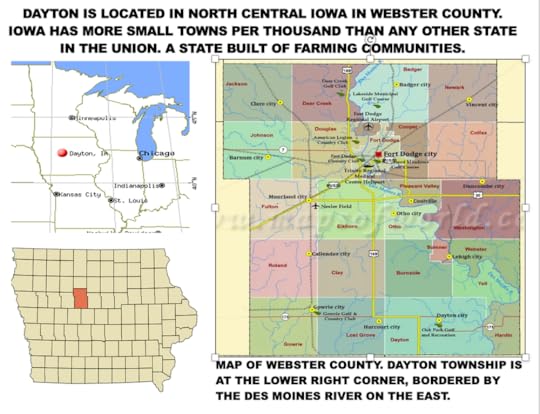
Can you imagine going West into a raw frontier to find your new home? To build a new life from the ground up? Meandering down the center of Iowa was another major river, the Des Moines. Land along this river was especially rich. Dayton was built about five miles from this river on one of its tributaries, Skillet Creek. The earliest history of white people coming to the area that would become Dayton, Iowa, dates back to 1850-51, only about four years after the territory became a state. According to the historical website IAGenWeb, the earliest white newcomers to Dayton "lived in caves in the hillside." (I would love to know where these caves are, as I have never heard of any caves in the Dayton area!)
Native Americans, of course, had been living in the area for tens of thousands of years. (SEE last week's post about the Skillet Creek Indian Mounds and the Woodland Indians.) The Woodland Indians had been the dominate culture for a thousand years but had been wiped out hundreds of years before. Other tribes had moved in, especially the Sioux and had settled along the Des Moines River.
The first white person to homestead in Dayton was Benjamin F. Allison, age 36, and his wife, Sarah, age 33, and their three toddlers. They came from Ohio via Indiana. They built a log cabin in southwestern Dayton, the area that would become known as "Old Minneapolis" perhaps because so many Scandinavians moved there. Later, the Minneapolis St. Louis Railroad Line (the MSL) would run through that area of town and a train depot would be built. (SEE a future post about this.) Some surmise this was the reason early Dayton was called Old Minneapolis, after the railroad.

Allison named the fledgling town "Dayton." (Why he chose this particular name is not known.) Allison purchased many acres of the Dayton area to develop into a community and laid out the first neighborhoods in "Old Minneapolis." He built the first sawmill on Skillet Creek that supplied the lumber for building the homes.
But development of Dayton as a thriving community would take decades. The map below shows the Township of Dayton in 1875, approximately nine miles wide and six miles deep. Dayton's earliest major homesteaders are recognizable today in modern times, many generations later. Notice that the name of the community is actually listed as "West Dayton." Perhaps this was to distinguish the small community from its eastern and much larger predecessor, Dayton, Ohio?


Below is a link to the 1860 Federal Census for the Dayton Township. Dayton folks, are any of your ancestors listed?
https://iagenweb.org/webster/census/1860/dayton.html
You may also enjoy these related posts:
• My Pioneer Motherhttps://www.notesfromthefrontier.com/post/my-pioneer-mother
https://www.notesfromthefrontier.com/post/how-log-cabins-were-built
https://www.notesfromthefrontier.com/post/women-homesteaders
"A Brief Early History of My Tiny Hometown: Dayton, Iowa" was first published on Facebook and Notes from the Frontier on April 23, 2024.
© 2024 NOTES FROM THE FRONTIER
April 12, 2024
Indian Mounds: A Favorite Childhood Haunt

The most profound part of my youth––aside from my love of reading and history––was riding my horse, Sundance, on Iowa country gravel roads and along the Des Moines River bottom exploring. I almost always rode him bareback and we explored so much near my hometown of Dayton, located in Webster County, Iowa. Old stagecoach trails, buffalo wallows, Indian mounds, an abandoned coal mine, pioneer cemeteries, abandoned barns that still had old draft horse harnesses hanging on the musty walls where they had been moldering for many decades. In an old barn, I even found a yellowed calendar from 1921. Those experiences informed my life and interest in history, especially Native American and pioneer history. And that led to my debut novel, Blood to Rubies.

One of my favorite places to explore was the winding gravel road that plunged deep down along the Des Moines River Valley. There was so much history there, including the abandoned coal mine town called Hardscrabble and the Skillet Creek Indian Mounds. That winding road through the hills also hid an old stagecoach trail that was overgrown but could still be tracked through the woods. The area was still rife with wildlife because the hills and river's shoreline were cloaked in thick forests. I saw foxes and bobcats and coyotes and eagles and huge bull snakes that were very uncommon to see in the 1970s, when DDT, farm chemicals and horrific water pollution savaged wildlife and caused a great decimation of species.
SKILLET CREEK INDIAN MOUNDS NEAR DAYTON
I was most fascinated by the Indian Mounds hidden in the forest. They seemed of the land, as their ancient inhabitants buried beneath had been. And my youthful imagination imagined what life might have been for them centuries, perhaps even thousands of years before.
The map shown above was developed by the Smithsonian in 1894, identifying the major Indian mound clusters in the United States east of the Missouri. You can see from the big map that Iowa was heavily dotted with them. Of course, many more were discovered after 1894. And many, many Indian mounds were simply plowed over by farmers who thirsted for fertile land. Because Iowa was largely flat prairie and was covered by the richest and deepest topsoil on earth, nearly every square mile of the state was surveyed and plotted out. Perhaps that is why so many Indian mound cluster were located.
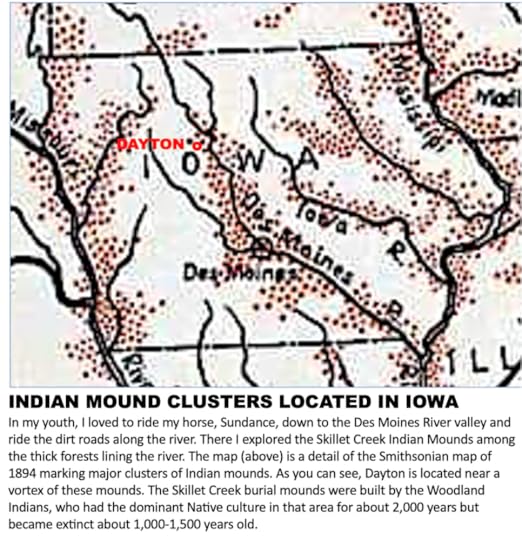
As whites moved West across the continent, many Indian tribes were driven West. (A case in point are the Mohicans. "The last of the Mohicans"––the small numbers who remain today––now live in Wisconsin, very, very far from their original home in the Catskill Mountains along the upper Hudson River of New York State.) The land that is now Iowa saw much cultural strife, as Eastern tribes (predominantly the Algonquins, the Chippewa, Pottawattamie, Powhatans, and other peoples) moved west the land nestled between the continent's two great rivers, the Mississippi and the Missouri. Western tribes, too (such as the Sioux, the Dakota, the Assiniboine, the Winnebago, and others), came down the Missouri. Both influxes converged upon the largely peaceful Mound Builders inhabiting the land nestled between the continent's two greatest rivers, the Mississippi and the Missouri. And running down the middle of that land was the Des Moines River.
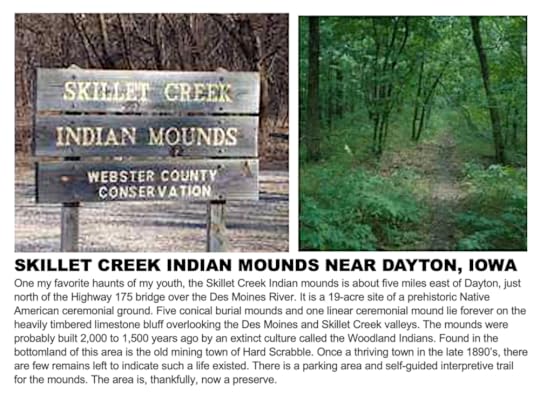
WOODLAND PEOPLE
For at least 11,000 years (modern research and archeology keeps moving that date earlier and earlier), Iowa and other Midwestern states were originally inhabited by various ancient peoples. About 3,000 years ago, the Mound Builders came to dominate the land now called Iowa. They were an agricultural race that grew corn, beans, pumpkins and sunflowers, gathered nuts and berries and hunted and fished for meat. They usually lived near rivers and streams and their burial mounds lined the rivers throughout the land. The tribe that lived along the Des Moines River was a subset of the Mound Builders called the Woodland people. Their culture was dominant for about two thousand years. The burial mounds that I often visited as a youth were built by the Woodland people.

THE IOWAS
The Woodland people eventually became extinct, having been absorbed or wiped out by encroaching tribes. In the midst of the Algonquins, a Dakota tribe cohabitated called the Iowas. The early French explorers, Marquette and Joliet, who navigated the Mississippi in 1673 called these Indians the "Ayouas." Lewis and Clark, in their 1805-180-6 journals, referred to these Indians as the "Ayouways." Eventually, the name was simplified to become the Iowa.
There is a movement in North America today to recognize the inhabitants of the land we occupy in the present day. Many universities, libraries and public buildings have installed plaques recognizing what Indigenous peoples inhabited that location originally. I welcome that movement and hope that it will help educate Americans, who are generally so notoriously ignorant of history. What I learned in my youth was that history is all around us. We need only open our minds and our hearts to it.
"Iowa Indian Mounds: My Childhood Haunts" was first published on Notes from the Frontier and Facebook on April 13, 2024.
You may also be interested in these related posts:
https://www.notesfromthefrontier.com/post/hunting-arrowheads
©2024 NOTES FROM THE FRONTIER
March 26, 2024
Blood to Rubies IMAGE SHOWCASE: Marian Gadzalski
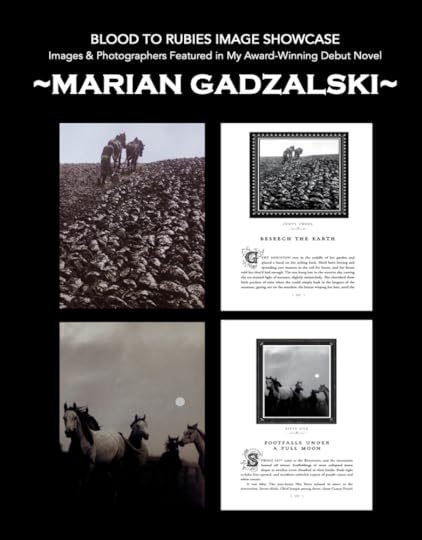
Marian Gadzalski was a Polish photographer who became famous world-wide for his magnificent photographs–both black and white and color–of horses. I did not learn about Gadzalski's work until after he died quite young in a car accident in Poland in 1987.
I had just graduated with a Master's in Journalism at the University of Iowa and went home to rural Iowa to help my mother take care of my dying grandmother. I was lucky to find one of the coolest jobs on the planet amidst the rural cornfields of Iowa; I became the marketing director for one of the leading Arabian Horse Farms in the world, Bru-Bet Arabians, during a time when the Arabian industry was on fire. I couldn't believe my luck! I'd grown up with horses, had them and ridden them all my life, and was even a rodeo queen. And I loved Arabian horses!
Bru-Bet Arabians was one of the leading Arabian breeders in the world and specialized in the Bask line. They had several world-champion stallions standing at stud, including JJ Jabask, who in 1985 was syndicated for $6 million!! Another stallion was High Hopes, five-time National Champion.

There were so many wonderful aspects of that job, but one of my favorites was placing advertising and editorial in the gorgeous magazines of the Arabian industry. There were three main publications (see below) and each month all three were at least an inch thick!

It was during my time at Bru-Bet that I read about Marian Gadzalski, when one of the magazines featured an 8-page spread on him and his work after he died. He often worked in black-and-white photography, and his images were simply awe-inspiring and so powerful. Below are some of the images featured "In Memoriam" of Marian Gadzalski in the magazine spread.
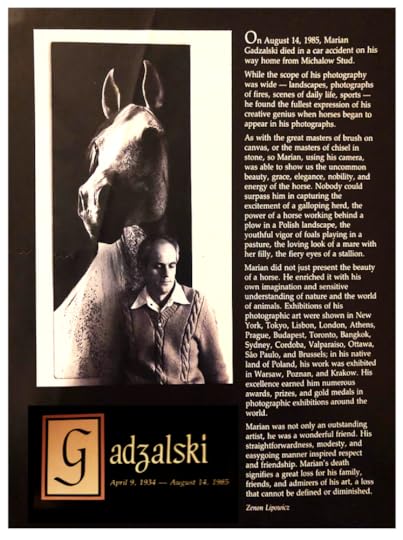
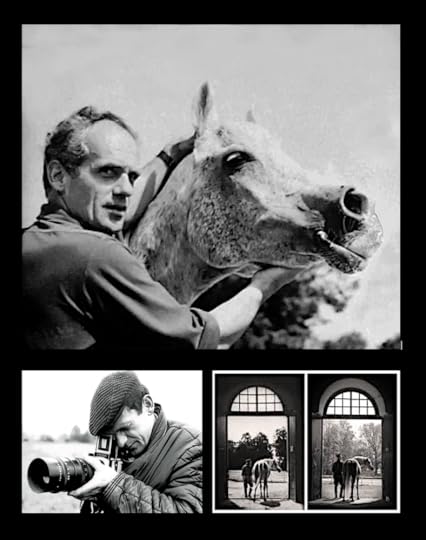
After I decided to feature black-and-white images as chapter headers in my novel, I knew right away that I wanted to use some of Gadzalski's images. I used these two (see below). The farmer with plow horse (left) is the header for the chapter, "beseech the earth." That chapter is about an old pioneer woman named Gert Houston, who remembers her husband, John, and two babies lost years before to an Indian raid. She had been in the woods collecting berries and survived. But even years later, she still yearned for John and remembered him working their prairie homestead.

The other image (right) of restive horses in the nighttime was used for the chapter, "footfalls under a full moon." In that chapter, Chief Joseph's band and other Nez Perce bands gather all their people and horses to convene at the Camas Prairie, a sacred ancestral ground of the Nimiipuu for many thousands of years, to begin their grueling 1,500-mile exodus to the Canadian border, rather than live in subjugation on the reservation. Both images capture so poignantly the narrative in each chapter.
Special Thanks
I am most grateful to Marian's two daughters, Hannah Gadzalski-Syfert and Ola Gadzalski, for generously granting permission to use their father’s photographs in this book, and to Artur Bober, director of the Polish Digital Equestrian Library. You can learn more about Marian Gadzalski and his work at: www.polishequestrianlegends.com and the website of the Polish magazine, Blok, www. blokmagazine.com/marian-gadzalski-konie-1978/.
About the Images in Blood to Rubies
My debut novel is extremely unique in historical fiction since it features 70 black-and-white images. I searched high and low to find these images and worked with the world's most iconic libraries, including the Smithsonian, Library of Congress, National Archives, the Beinecke Rare Book Library at Yale University, the National Park Service, the Nez Perce Historical Park Service, the Polish Digital Equestrian Library, special private collections, and many state historical societies. The images help tell the story of my main character, a fictional frontier photographer, Frederick Cortland. Many are 1800s archival images from real frontier photographers. But some are from the world's leading contemporary photographers of the American West, of horses, and of the Nez Perce.
To learn more about the other photographers and their work featured in Blood to Rubies, see links below.
THANK YOU ALL FOR SHARING THIS JOURNEY WITH ME❣️
"Blood to Rubies IMAGE SHOWCASE: Marian Gadzalski" was originally posted March 27, 2024 on NotesfromtheFrontier.com and Facebook.
You may also enjoy these related IMAGE SHOWCASES of other world-renown photographers featured in ,Blood to Rubies,:
• https://www.notesfromthefrontier.com/post/blood-to-rubies-image-showcase-erika-larsen
• https://www.notesfromthefrontier.com/post/blood-to-rubies-image-showcase-david-jensen
• https://www.notesfromthefrontier.com/post/blood-to-rubies-image-showcase-paul-wakefield
• https://www.notesfromthefrontier.com/post/blood-to-rubies-image-showcase-chuck-haney
• https://www.notesfromthefrontier.com/post/blood-to-rubies-image-showcase-randolph-fritz
• https://www.notesfromthefrontier.com/post/blood-to-rubies-image-showcase-david-jensen
• https://www.notesfromthefrontier.com/post/blood-to-rubies-image-showcase-ansel-adams
• https://www.notesfromthefrontier.com/post/blood-to-rubies-image-showcase-marian-gadzalski
• https://www.notesfromthefrontier.com/post/blood-to-rubies-image-showcase-hughes-photography
©2024 NOTES FROM THE FRONTIER
March 19, 2024
Unraveling the Truth: Red Clay, Running Waters and the Prologue of the Trail of Tears
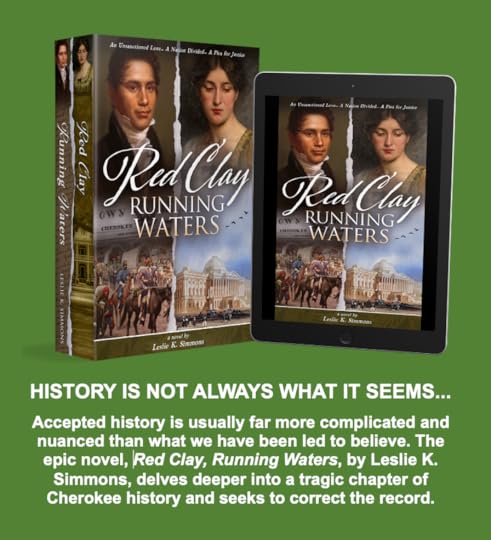
One of the wonderful aspects of becoming a debut author is meeting other authors, sharing our stories of our writing journeys, and seeing years of work pay off. I've been lucky to meet many excellent writers, especially Leslie K. Simmons, who also published with Koehler Books, and also wrote a deeply researched historical novel about Native Americans.
Leslie's debut book, Red Clay, Running Waters, and my debut novel, Blood to Rubies, both share themes of Native American tribes facing a terrible dilemma: how to survive in a changing white world. Leslie writes about a Cherokee leader, John Ridge, and his white wife Sarah, in the 1830s who struggle to navigate a changing world in which white immigrants from Europe have come to the New World in dramatic numbers, encroaching on Cherokee land. Another shared theme is that both Indian tribes, the Nez Perce in my novel and the Cherokee in Leslie's, struggled in earnest to co-exist with whites and accepted many of their ways and religion, so the historical outcomes were even more deeply ironic and tragic.
Red Clay, Running Waters is a tour-de-force of both exhaustive research and powerful narrative. Leslie's real-life characters come alive, rising from the pages into your heart as you experience their struggle to preserve a free Cherokee Nation. Red Clay, Running Waters has received accolades from NYT bestselling authors, such as Rilla Askew (The Mercy Seat, Prize for the Fire, Fire in Beulah) and the great Cherokee author, Margaret Verble (Maud's Line, Cherokee America, Stealing).
Following is a Q&A with Leslie about Red Clay, Running Waters:
[image error]1. The original inspiration for your book came from a home you admired while attending college in Arkansas. Tell us about that.
LS: The Sarah Ridge House is the oldest house in Fayetteville Arkansas, dating back to the 1830s. I love old houses and have restored two historic homes. I was a student at the University of Arkansas in Fayetteville, studying Anthropology, and worked in the museum that held artifacts from an excavation at the house. I was told the house once belonged to a widow, a white woman married to a Cherokee leader. This struck me as very unusual for the time, as White women marrying Native Americans was not a common practice in the early 1800s. Curiosity piqued, I began to research Sarah Ridge at the local historical society and uncovered a lot of intriguing information. What I found created a burning desire in me to know more, leading me to undertake many more years of research, ultimately resulted in Red Clay, Running Waters. The house, now owned by the Washington County Historical Society and open to the public on a limited basis, displays some of the very artifacts I handled back in 1982.
2. North American tribes all faced a terrible dilemma: how to survive the white onslaught. The main character of your book, John Ridge, was the son of a great Cherokee leader, called "The Ridge." John’s parents thought it best that he be educated in white ways to better serve his tribe. He ended up being caught between two worlds. Can you explain his dilemma?
LS: Well, that takes the whole book to unravel, but beginning at the beginning, John, along with his cousin Elias, were seen as the hope of the Cherokee Nation after they returned from New England with a ‘classical’ education. Proving they could ‘assimilate’ was a huge honor, imbuing a great sense of responsibility, pride and purpose in John, his cousin, and John’s father. Armed with an understanding of white society, the Cherokee held the belief they would be recognized for their ‘advancement’, eventually proving their capabilities, so they could enjoy equality and live peacefully beside their White neighbors.
Cherokee society enjoyed a renaissance of sorts during the 1820s, forming a republican government, developing written laws, and creating their own written language. However, the assumption of equality, so connected to the issue of ‘rights’, soon proved elusive, turning their aspirations, accomplishments, and expectations on their head.
Understanding both worlds, John steadfastly sought a balance between Cherokee traditions and ‘civilized’ ways throughout his life. This was something he waged a constant battle to resolve. Although he dressed, wrote, spoke, and lived in a manner similar to Southern whites (as many in Cherokee leadership did) his heart was always deeply committed to his people first and foremost. He was highly principled, analytical, bitingly eloquent, and never considered himself or his people inferior, striving to prove this to both whites and Cherokee through his actions. This made him enemies within white society, and among his own people, who often viewed him as ‘selling out’ because of his attitudes and lifestyle. These character traits became the source of many misunderstandings, giving ample opportunity for whites to slander his efforts to their advantage. It also accounted for a great deal of his tarnished historical reputation among the Cherokee.
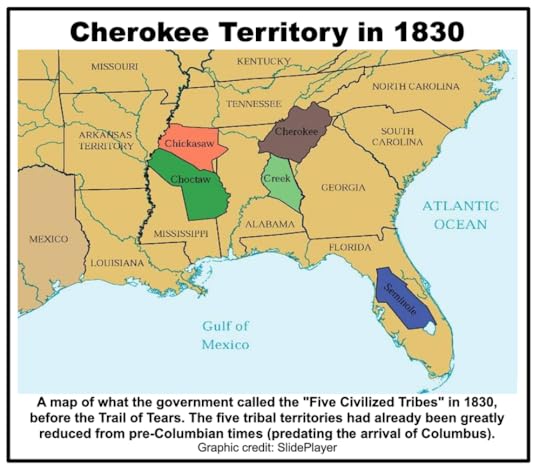
3. Red Clay, Running Waters is almost as much about John Ridge’s wife, Sarah, who was a very educated and strong white woman. This inter-racial marriage was shocking and illegal in 1824. Why did you choose to feature her so prominently in the book?
LS: My learning about the Ridges’ story, and consequently the Trail of Tears, started with Sarah. I was equally as interested in what she experienced because of her choices as I was in John’s remarkable journey. At a time in American society when women were relegated to their ‘separate spheres’ and laws against miscegenation common, I knew Sarah must have been a remarkable, independent woman, with strong convictions and enough courage to withstand the enmity of her own society against her marriage. To willingly leave everything she knew for the man she loved and commit to joining his people required more than your average fortitude in a time when most women rarely ventured from the places in which they were raised.
Although there exist scads of John’s writing, only a few pieces from Sarah exist from which to glean her personality and thoughts. I had to believe John’s character had some reflection in hers. She, after all, embraced a life amongst strangers who didn’t speak her language and had different world views. She was also obliged to adopt a southern plantation lifestyle among many enslaved people, something that would have been alien to her New England sensibility. It was confronting these paradoxes that captured my imagination.
Though a true friend and partner to John, she was often alone while he was in Washington, leaving her to manage their vast holdings in Georgia and raise their seven children while she fostered education and remained steadfast in face of the extremities imposed upon the Cherokee. Along with her unflinching support for John, she remained, as he said, his ‘only sanctuary’. I came away with the deepest admiration for their love for each other and what she accomplished and endured. I wanted her voice to be heard.

4. Your quote from John Ridge in the beginning of your book leaves it to posterity to judge his motives and stance in history. Red Clay, Running Waters is your very eloquent and compelling exoneration of John Ridge. But Ridge’s stance among his own people and the annals of history has not been so kind. Talk about this.
LS: The motivators for writing the Ridges’ story were two-fold. One, living near the Cherokee Nation in Oklahoma, I developed a deep desire to understand how such a thing as the Trail of Tears could have happened. I knew little (and had been taught even less) about the Antebellum Era and Indian Removal; understanding that era transformed my understanding of America, which I wanted to share. Two, although there are volumes and volumes of non-fiction books and materials written about this era, the Cherokee, and the transformative social changes of that time, I knew that the Ridges’ side, in particular John’s side of the story behind the Trail of Tears, had never been told. He and his family received much of the blame for the tragic events of the Removal and the Trail; many among the Cherokee still consider the Ridges traitors.
I felt compelled to understand how a once prestigious family went from respected leaders to pariahs. In satisfying my curiosity, dichotomies between John’s historical reputation and the person revealed in his actions surfaced that were so contradictory, I felt compelled to unravel them. When I came across that quote in a letter he wrote, his voice reached out to me, calling out for what he most longed for, redemption, and their story became a smoldering ember that could not be extinguished.
Read more about Red Clay, Running Waters and purchase a hardcover, paperback or Kindle at this link:
You may also enjoy these related Notes from the Frontier posts:
• Cherokee Chief Wilma ManKiller• Today's Largest Indian Tribeshttps://www.notesfromthefrontier.com//post/today-s-largest-indian-tribes
• The Sacred Bond Between the Irish & The Choctawhttps://www.notesfromthefrontier.com//post/the-sacred-bond-between-the-irish-and-the-choctaw
"Unraveling the Truth: Red Clay, Running Waters and the Prologue of the Trail of Tears" (a novel about Cherokee leader John Ridge) was first published on Facebook and ,NotesfromtheFrontier.com on March 21, 2024, Thursday.
© 2024 NOTES FROM THE FRONTIER
Unraveling the Truth: Red Clay, Running Waters and the Prologue of the Trail of Tears
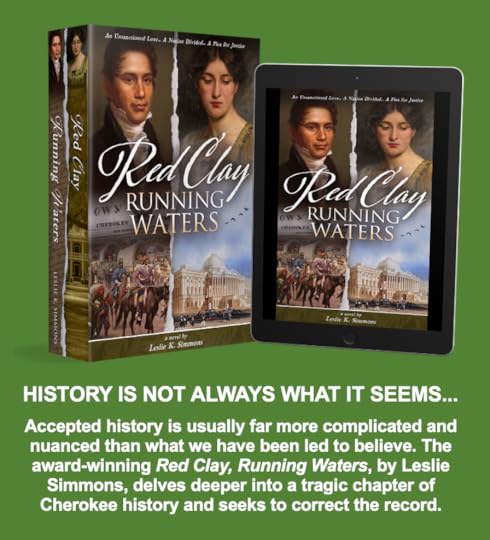
One of the wonderful aspects of becoming a debut author is meeting other authors, sharing our stories of our writing journeys, and seeing years of work pay off. I've been lucky to meet many excellent writers, especially Leslie Simmons, who also published with Koehler Books, and also wrote a deeply researched historical novel about Native Americans.
Leslie's award-winning debut book, Red Clay, Running Waters, and my debut novel, Blood to Rubies, both share themes of Native American tribes facing a terrible dilemma: how to survive in a changing white world. Leslie writes about a Cherokee leader, John Ridge and his white wife Sarah, in the 1830s who struggle to navigate a changing world in which white immigrants from Europe have come to the New World in dramatic numbers, encroaching on Cherokee land. Another shared theme is that both Indian tribes, the Nez Perce in my novel and the Cherokee in Leslie's , struggled in earnest to co-exist with whites and accepted many of their ways and religion, so the historical outcomes were even more deeply ironic and tragic.
Red Clay, Running Waters is a tour-de-force of both exhaustive research and powerful narrative. Leslie's real-life characters come alive, rising from the pages into your heart as you experience their struggle to preserve a free Cherokee Nation. Red Clay, Running Waters has won awards and accolades from NYT bestselling authors, such as Rilla Askew (The Mercy Seat, Prize for the Fire, others) and the great Cherokee author, Margaret Verble (Maud's Line).
Following is a Q&A with Leslie about Red Clay, Running Waters:

1. The original inspiration for your book came from a home you admired in your youth growing up in Arkansas. Tell us about that.
LS: The Sarah Ridge House is the oldest house in Fayetteville Arkansas, dating back to the 1830s. I love old houses and have restored two historic homes. I was a student at the University of Arkansas in Fayetteville, studying Anthropology, and worked in the museum that held artifacts from an excavation at the house. I was told the house once belonged to a widow, a White woman married to a Cherokee leader. This struck me as very unusual for the time, as White women marrying Native Americans was not a common practice in the early 1800s. Curiosity piqued, I began to research Sarah Ridge at the local historical society and uncovered a lot of intriguing information. What I found created a burning desire in me to know more, leading me to undertake many more years of research, ultimately resulted in Red Clay, Running Waters. The house, now owned by the Washington County Historical Society and open to the public on a limited basis, displays some of the very artifacts I handled back in 1982.
2. North American tribes all faced a terrible dilemma: how to survive the white onslaught. The main character of your book, John Ridge, was the son of a great Cherokee leader. John’s parents thought it best that he be educated in white ways to better serve his tribe. He ended up being caught between two worlds. Can you explain his dilemma?
LS: Well, that takes the whole book to unravel, but beginning at the beginning, John, along with his cousin Elias, were seen as the hope of the Cherokee Nation after they returned from New England with a ‘classical’ education. Proving they could ‘assimilate’ was a huge honor, imbuing a great sense of responsibility, pride and purpose in John, his cousin, and John’s father, Major Ridge. Armed with an understanding of White society, the Cherokee held the belief they would be recognized for their ‘advancement’, eventually proving their capabilities, so they could enjoy equality and live peacefully beside their White neighbors.
Cherokee society enjoyed a renaissance of sorts during the 1820s, forming a republican government, developing written laws, and creating their own written language. Hoowever, the assumption of equality, so connected to the issue of ‘rights’, soon proved elusive, turning their aspirations, accomplishments, and expectations on their head.
Understanding both worlds, John steadfastly sought a balance between Cherokee traditions and ‘civilized’ ways throughout his life. This was something he waged a constant battle to resolve. Although he dressed, wrote, spoke, and lived in a manner similar to Southern Whites (as many in Cherokee leadership did) his heart was always deeply committed to his people first and foremost. He was highly principled, analytical, bitingly eloquent, and never considered himself or his people inferior, striving to prove this to both Whites and Cherokee through his actions. This made him enemies within White society, and among his own people, who often viewed him as ‘selling out’ because of his attitudes and lifestyle. These character traits became the source of many misunderstandings, giving ample opportunity for Whites to slander his efforts to their advantage. It also accounted for a great deal of his tarnished historical reputation among the Cherokee.
[image error]3. Red Clay, Running Waters is almost as much about John Ridge’s wife, Sarah, who was a very educated and strong white woman. This inter-racial marriage was shocking and illegal in 1824. Why did you choose to feature her so prominently in the book?
LS: My learning about the Ridges’ story, and consequently the Trail of Tears, started with Sarah. I was equally as interested in what she experienced because of her choices as I was in John’s remarkable journey. At a time in American Society when women were relegated to their ‘separate spheres’ and laws against miscegenation common, I knew Sarah must have been a remarkable, independent woman, with strong convictions and enough courage to withstand the enmity of her own society against her marriage. To willingly leave everything she knew for the man she loved and commit to joining his people required more than your average fortitude in a time when most women rarely ventured from the places in which they were raised.
Although there exist scads of John’s writing. only a few pieces from Sarah exists from which to glean her personality and thoughts. I had to believe John’s character had some reflection in hers. She, after all, embraced a life amongst strangers who didn’t speak her language and had different world views. She was also obliged to adopt a southern plantation lifestyle among many enslaved people, something that would have been alien to her New England sensibility. It was confronting these paradoxes that captured my imagination.
Though a true friend and partner to John, she was often alone while he was in Washington, leaving her to manage their vast holdings in Georgia and raise their seven children while she fostered education and remained steadfast in face of the extremities imposed upon the Cherokee. Along with her unflinching support for John, she remained, as he said, his ‘only sanctuary’. I came away with the deepest admiration for what she accomplished and endured, and I wanted her voice to be heard.
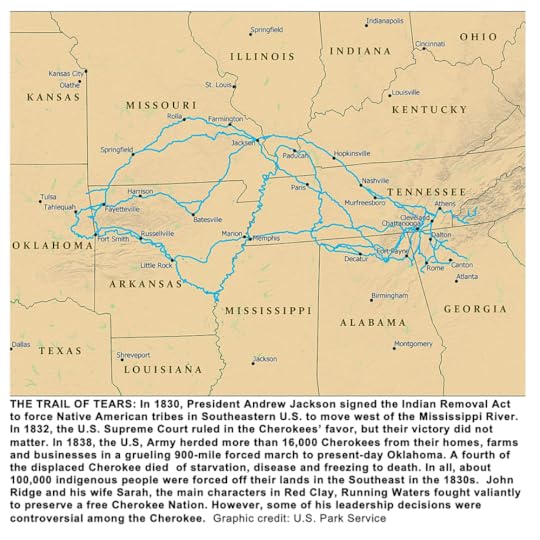
4. Your quote from John Ridge in the beginning of your book leaves it to posterity to judge his motives and stance in history. Red Clay, Running Waters is your very eloquent and compelling exoneration of John Ridge. But Ridge’s stance among his own people and the annals of history has not been so kind. Talk about this.
LS: The motivators for writing the Ridges’ story were two-fold. One, living near the Cherokee Nation in Oklahoma, I developed a deep desire to understand how such a thing as the Trail of Tears could have happened. I knew little (and had been taught even less) about the Antebellum Era and Indian Removal; understanding that era transformed my understanding of America, which I wanted to share. Two, although there are volumes and volumes of non-fiction books and materials written about this era, the Cherokee, and the transformative social changes of that time, I knew that the Ridges’ side, in particular John’s side of the story behind the Trail of Tears, had never been told. He and his family received much of the blame for the tragic events of the Removal and the Trail; many among the Cherokee still consider the Ridges traitors.
I felt compelled to understand how a once prestigious family went from respected leaders to pariahs. In satisfying my curiosity, dichotomies between John’s historical reputation and the person revealed in his actions surfaced that were so contradictory, I felt compelled to unravel them. When I came across that quote in a letter he wrote, his voice reached out to me, calling out for what he most longed for, redemption, and their story became a smoldering ember that could not be extinguished.
Read more about Red Clay, Running Waters and purchase a hardcover, paperback or Kindle at this link:
You may also enjoy these related Notes from the Frontier posts:
• Cherokee Chief Wilma ManKiller• Today's Largest Indian Tribeshttps://www.notesfromthefrontier.com//post/today-s-largest-indian-tribes
• The Sacred Bond Between the Irish & The Choctawhttps://www.notesfromthefrontier.com//post/the-sacred-bond-between-the-irish-and-the-choctaw
"Red Clay, Running Waters" (a novel about Cherokee leader John Ridge) was first published on Facebook and ,NotesfromtheFrontier.com on March 21, 2024, Thursday.
© 2024 NOTES FROM THE FRONTIER
https://www.NotesfromtheFrontier.com
- Deborah Hufford's profile
- 42 followers



